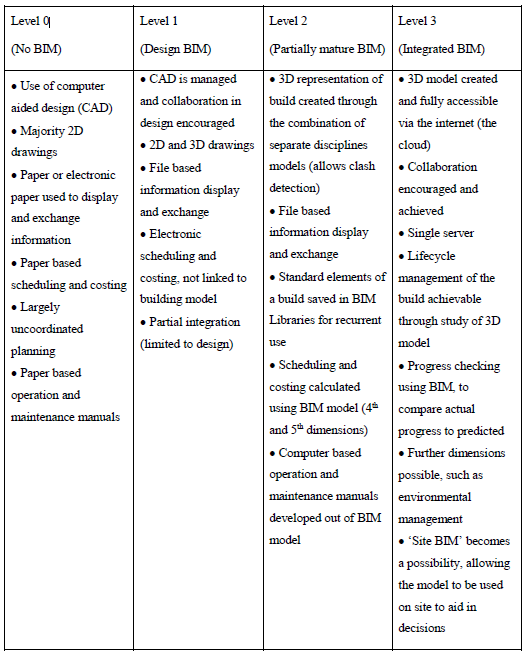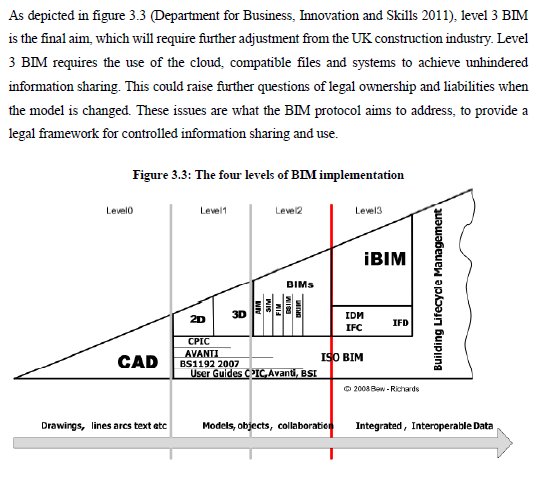The following is from a Master’s thesis prepared by James Murray as part of the MSc individual project 2012/13, via: http://www.4Clicks.com – http://www.4Clicks.com – Premier cost estimating and efficient project delivery software supporting JOC, SABER, IDIQ, SATOC, MATOC, MACC, POCA, BOA … and featuring integrated contract, project, document management, visual estimating/quanity take-off. QTO, and an exclusively enhanced 400,000 line itme RSMeans Cost database
The study centered upon the development of Building Information Modelling (BIM) in the UK construction industry and its pontential affect on the role of the client’s construction manager (CM).
BIM in the UK was not as advanced as claimed in the literature.
The majority of BIM use remained in the design, procurement and planning stages and as such, only isolated current impacts on the CM were suggested.
More guidance is needed, in order to place BIM in the future of UK construction…. if this does not occur, the development of BIM may stall.
Potential impacts to the CM range from increased efficiencies on site, to loss of project control and increased legislation.
The UK government 2016 deadline for BIM implementation on all UK public construction projects almost guarantees BIM in the future.
The problem with the Construction sector – ‘In a building project, each partner usually plays a specific role. This role follows from the partners’ primary interest, and results in a specific view on the building. A designer’s primary interest is for example the spatial structure, a structural engineer’s primary interest is the load bearing structure, while an energy engineer is interested in climate zones.
As a result of this, buildings and building parts are viewed differently by each partner…’(van Nederveen and Tolman in 1992)
The Origins of BIM -” BIM (Building Information Modelling/ Building Information Management) is a combination of 3D modelling technology and an open and sharing culture (Davies & Harty 2013). The first documented use of the term BIM can be dated back to 1992 (van Nederveen & Tolman). However, the theories behind the culture of BIM can be dated to 1975, when C.M Eastman suggested the use of integrated databases and standardized drawings to aid in project control (Eastman, Teicholz, Sacks & Liston 2008). The software vendor’s competition for BIM dominance began in 1997, after the launch of Autodesk’s Revit Architecture software (Hasan & Yolles 2009). This has since developed into a thriving market, which has resulted in a series of slightly different, competing BIM applications (Howell & Batcheler 2005). The combination of culture and technology makes BIM unique. To perform BIM on a project, members of the team blend the use of modelling technologies, with behaviors and policies that run throughout a project lifecycle, from cradle to grave (Autodesk 2011).”
“The combination of culture and technology makes BIM unique. To perform BIM on a project, members of the team blend the use of modelling technologies, with behaviors and policies that run throughout a project lifecycle, from cradle to grave (Autodesk 2011).”
“The cultural aspect of BIM implementation requires all contributors to a project to openly share information they hold about the build with the other parties to the contract (Eastman et al 2008). It is this sharing culture that is considered revolutionary in the construction industry, as it is a move away from traditional trends of secretive parties and regular disputes (Davies & Harty 2013).”
Industry resistance to change “ BIM requires a change in culture to implement the technology available. For example, the use of the BIM model to produce cost and time estimates has been identified as a paradigm shift (Gier 2008). A paradigm shift is a change from an established process and school of thought, to a new one, thus creating a change in cultures. It is in this paradigm shift where the barrier lies. As identified in the Egan report, 1998, the UK construction industry has a reputation of being slow to accept change (Egan 1998), which has caused it to lag behind the adoption of 3D modelling, when compared to other industries (Cabinet Office 2011).
This reluctance to change could also create resistance to overcoming the barriers of trust detailed above. To increase trust, a change away from the current culture of information hording, to one of sharing and transparency should be made.
These barriers of trust and culture could have secondary impacts on the CM, whereby if they are not removed the benefits of BIM may not be realised.”
BIM Levels:
BIM





